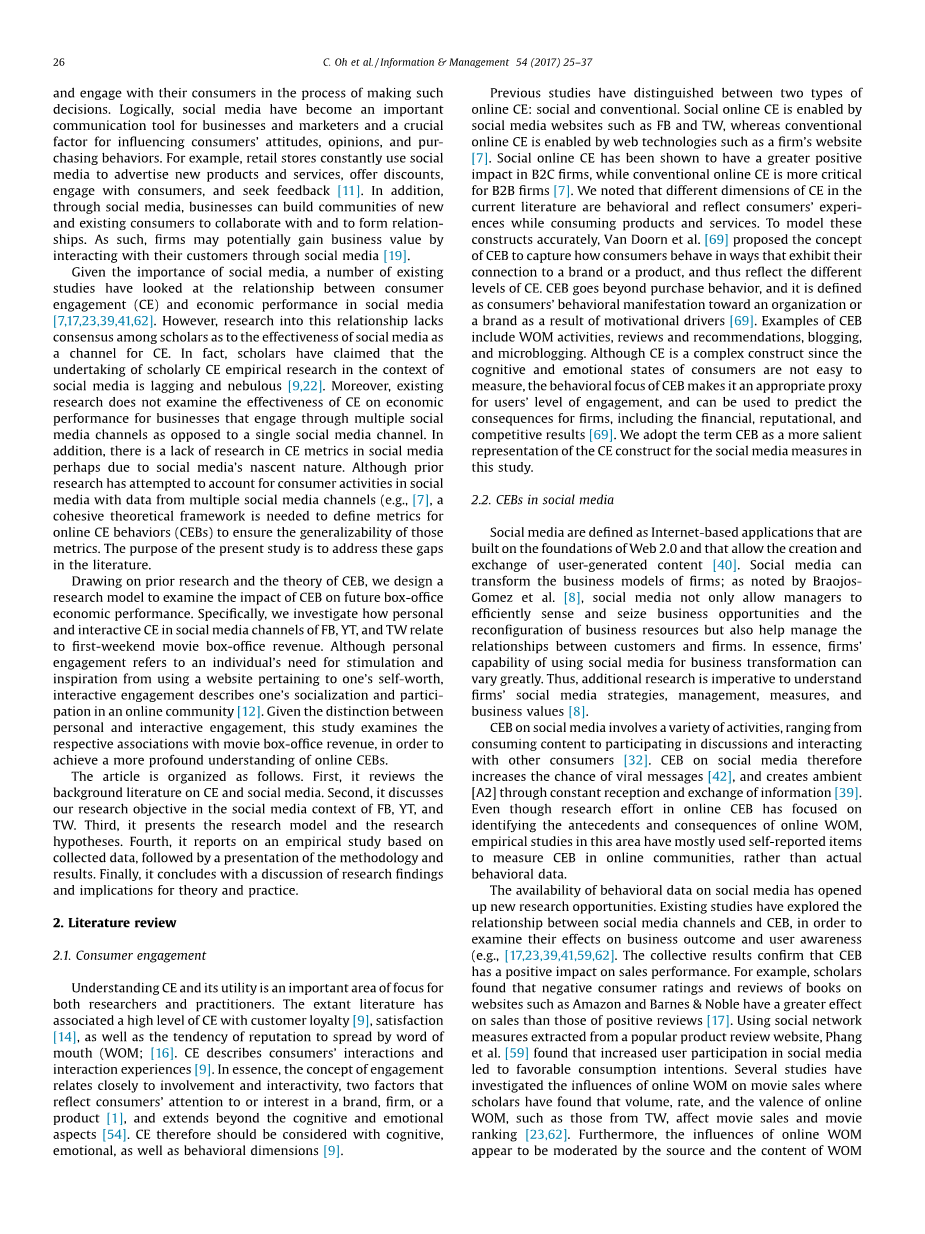外文翻译资料
2022-12-29 11:48:41
本科毕业设计(论文)
外文翻译
Beyond likes and tweets: Consumer engagement behavior and movie box office in social media
作者:Chong Oha, Yaman Roumanib, Joseph K. Nwankpac, Han-Fen Hud
国籍:a Department of Operations amp; Information Systems, David Eccles School of Business, University of Utah, Salt Lake City, UT 84112, United States
b Department of Computer Information Systems, College of Business, Eastern Michigan University, Ypsilanti, MI 48197, United States
c Department of Information Systems, College of Business and Entrepreneurship, The University of Texas – Rio Grande Valley, 1201 W. University Drive, Edinburg, TX 78539-2999, United States
d Department of Management, Entrepreneurship, and Technology, Lee Business School, University of Nevada, Las Vegas Las Vegas, NV 89154, United States
出处: Oh C , Roumani Y , Nwankpa J K , et al. Beyond Likes and Tweets: Consumer Engagement Behavior and Movie Box Office in Social Media[J]. Information amp; Management, 2016:S0378720616300271.
原文正文:
ABSTRACT :This study examines the effects of social media, from the perspective of consumer engagement behavior (CEB), to investigate how CEB is associated with economic performance. Based on social media activities surrounding US movies, we used ordinary least square (OLS) regression models and found that CEB on Facebook and YouTube positively correlate with box-office gross revenue; however, the same effect was not observed on Twitter. This study proposed and tested a set of metrics for CEB on social media, and also provided empirical support for associating CEB with economic performance. The results underscore the importance of investing in social media communication across multiple channels.
Keywords:Social media,Social media analytics ,Consumer engagement behavior ,Personal engagement ,Interactive engagement,Movie box office
1. Introduction
Edge of Tomorrow, the much anticipated blockbuster film starring Tom Cruise, debuted in US cinemas nationwide on 6 June 2014 and grossed 28.7 million in its opening weekend. It was unexpectedly overshadowed by Fault in Our Stars, a 12 million budget movie with 48 million opening-weekend revenue. While Edge of Tomorrow cost the producer Warner Bros. a whopping 178 million in production budget and a return on investment (ROI) of 16%, Fault in Our Stars exceeded all expectations with its ROI of 400%.
Movie marketing executives are constantly perplexed and dumbfounded by such outcomes. A pertinent question arises: “What are reliable indicators of a moviersquo;s box office performance?” Perhaps social media can help predict [A1] future fiscal perform- ances of movie releases. According to Forbes [53],Faultrsquo;s “strong [social media] buzz would interest people outside of the converted . . . .” The social media measures of both movies on the release day seemed to support this statement. Edge of Tomorrow had 444,000 Facebook (FB) likes and a 195,000 talk count, whereas Fault in Our Stars had 4.6 million FB likes and a 2.4 million talk count. These numbers showed that the wide division between the economic performances of the two movies was also reflected in their social media activities. To a certain degree, a moviersquo;s social media activities may well be a preview of the moviersquo;s future economic performance.
With the explosive growth of the Internet as well as Web 2.0 technologies [64], people are turning away from such traditional media as television, radio, magazines, and newspapers toward online social media [49]. Such social media sites as FB (http://facebook.com), YouTube (YT: http://youtube.com), and Twitter (TW: http://twitter.com) have become essential commu- nication tools for millions of people-in short, they have become ubiquitous. Recent reports have shown that there are more than one billion monthly active users on FB [24] and YT [77], and 288 million monthly active users on TW [68]. Unlike traditional media, online social media have given the public more control over the content, frequency, and timing of generated information, and have provided them with immediate access to information at their own convenience [72]. More importantly, consumers are also using social media to search for information pertaining to purchasing decisions [72].
The success of businesses depends on consumersrsquo; purchasing decisions and the ability of organizations to influence, encourage, and engage with their consumers in the process of making such decisions. Logically, social media have become an important communication tool for businesses and marketers and a crucial factor for influencing consumersrsquo; attitudes, opinions, and pur- chasing behaviors. For example, retail stores constantly use social media to advertise new products and services, offer discounts, engage with consumers, and seek feedback [11]. In addition, through social media, businesses can build communities of new and existing consumers to collaborate with and to form relation- ships. As such, firms may potentially gain business value by interacting with their customers through social media [19].
Given the importance of social media, a number of existing studies have looked at the relationship between consumer engagement (CE) and economic performance in social media [7,17,23,39,41,62]. However, research into this relationship lacks consensus among scholars as to the effectiveness of social media as a channel for CE. In
剩余内容已隐藏,支付完成后下载完整资料


英语原文共 13 页,剩余内容已隐藏,支付完成后下载完整资料
资料编号:[276473],资料为PDF文档或Word文档,PDF文档可免费转换为Word




